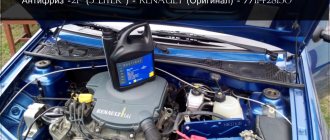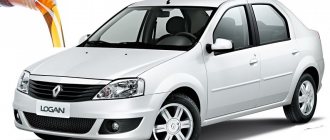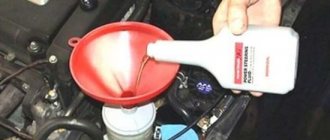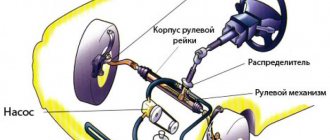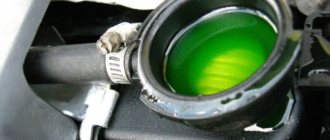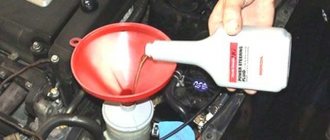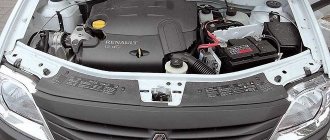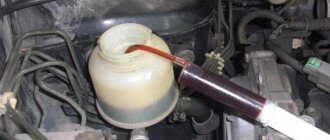The Renault Logan model is equipped with a “classic” type of power steering. This type is usually classified as hydraulic power steering, in which the working fluid is a special power steering fluid (power steering oil). At the same time, changing the Renault Logan power steering oil is considered a mandatory procedure, since during the operation of the car the fluid loses its properties.
As a result, the hydraulic booster:
- can work with increased load and make noise;
- loaded elements are subject to heavy loads and wear out faster;
- The steering wheel may rotate jerkily, with different forces, etc.
To achieve maximum functionality of the amplifier and driving comfort, as well as to increase the power steering resource, the working fluid must be changed, on average, every 50-60 thousand kilometers. You should also replace it immediately if the power steering fluid is dirty or has changed its properties. At the same time, you can service the Renault Logan power steering with your own hands in a regular garage. Read more in our article.
Types of power steering for Renault Logan
Cars are equipped with the following types of hydraulic boosters:
- Power steering with electric pump. The principle of operation of the mechanism is that the lubricating fluid is pumped through a pump. It, in turn, operates thanks to a car generator. The hydraulic “electric booster” operates in certain phases. It is expensive to operate and maintain, and is usually installed on expensive cars.
- Power steering MSV with belt pump. Renaut Logan cars with an engine capacity of 4 and 1.6 liters for 75 and 87 hp. are equipped with just such a mechanism that facilitates the rotation of the steering wheel. The belt wears out over time, but installing a new one is not difficult.
As for the pump itself, a classic device is installed on Logan. It has proven itself well, thanks to stable operation and rare breakdowns.
Petrol 1.4 and 1.6
The oil filter for gasoline Renault Logan and 1st and 2nd generations are used the same.
It doesn't matter if the engine is 8 or 16 valve. A filter with Renault article number 77 00 274 177 is installed on this car from the factory. This original spare part is installed directly from the factory and can be “safely” purchased for routine maintenance. In catalogs, the filter may also be under other OEM numbers: 8200768913, 8200867976 and 7700033408. The Renault Logan oil filter has an outer diameter of 76 mm, an inner diameter of 62 mm. The valve opening pressure is 1.3 bar.
Not original filters that are suitable (can be safely used) for Logan Bosch 0 451 103 336, CHAMPION COF100136S and Mann-Filter W 75/3.
Bosch 0 451 103 336 filter size exceeds the original by 2 mm, but this does not create any problems. Everything falls neatly into place. The anti-drainage valve is made of soft silicone. The pressure plate acts as a spring.
CHAMPION COF100136S – filter identical in size to the original. The filter element occupies 552 cm2. High-quality filling with sealant. Durable plastic acts as the basis for the bypass valve. But the check valve is made of rubber, which tends to harden in frosty weather. Please keep this in mind before purchasing. Overall a good choice for Logan.
Mann-Filter W 75/3 – the main filter element is made of synthetics. Dimensions are similar to the original product. It is very popular.
When should you change the oil?
The oil change in the power steering, according to the manufacturer's recommendations, should be carried out every 2 years or 40 thousand kilometers. The frequency of replacement varies depending on the age of the vehicle. Thus, models of 2006, 2007, 2008, 2009, 2010 require more frequent maintenance and replacement of lubricant. For older cars, the optimal mileage will be 25–30 thousand kilometers. As for the more “fresh” models of 2011, 2012, 2013, 2014, 2015, 2016, 2022, these cars are subject to the first replacement at around 40 thousand kilometers. And when buying a used car, experts advise immediately filling the power steering with new lubricant.
If you ignore the manufacturer's recommendations, the responsiveness of the steering wheel will deteriorate over time, and later malfunctions will occur in the entire steering system of the car.
Problems may arise before the recommended fluid change period has expired. For example, when the lubricant in the reservoir has a rich dark color, this indicates the presence of metal particles in it. In addition, this oil smells burnt. Such fluid must be replaced immediately. Also, the lubricant should be changed when the vehicle has not been used for a long time. The reason is the occurrence of condensate in the hydraulic power steering system, which, when mixed with liquid, forms an emulsion and contributes to the loss of all properties of the power steering lubricant.
Select the vehicle modification to search for power steering fluid
- Renault Logan I LS Sedan 1.0 Hi-Flex 76 hp id11675 Engine: volume - 1 liter, power - 76 hp, type - petrol. Drive: front. Year of release: 2007-2021
- Renault Logan I LS Sedan 1.4 75 hp id24524 Engine: volume - 1.4 l., power - 75 hp, type - petrol, model - K7J 710. Drive: front-wheel drive. Year of manufacture: 2004-2021
- Renault Logan I LS Sedan 1.6 87 hp id24525 Engine: volume - 1.6 liters, power - 87 hp, type - petrol, model - K7M 710. Drive: front-wheel drive. Year of manufacture: 2004-2021
- Renault Logan I LS Sedan 1.6 90 hp id11676 Engine: volume - 1.6 liters, power - 90 hp, type - petrol. Drive: front. Year of release: 2008-2021
- Renault Logan I LS Sedan 1.6 Flex 92 hp id11677 Engine: volume - 1.6 liters, power - 92 hp, type - petrol. Drive: front. Year of release: 2007-2021
- Renault Logan I LS Sedan 1.6 Flex 95 HP id101075 Engine: volume - 1.6 liters, power - 95 hp, type - petrol. Drive: front. Year of release: 2007-2021
- Renault Logan I LS Sedan 1.6 105 hp id25660 Engine: volume - 1.6 liters, power - 105 hp, type - petrol, model - K4M 690. Drive: front-wheel drive. Year of release: 2007-2021
- Renault Logan I LS Sedan 1.6 Flex 107 hp id11678 Engine: volume - 1.6 liters, power - 107 hp, type - petrol. Drive: front. Year of release: 2007-2021
- Renault Logan I LS Sedan 1.6 109 hp id11687 Engine: volume - 1.6 liters, power - 109 hp, type - petrol. Drive: front. Year of release: 2007-2021
- Renault Logan I LS Sedan 1.6 112 hp id57894 Engine: volume - 1.6 liters, power - 112 hp, type - petrol, model - K4M 697. Drive: front-wheel drive. Year of release: 2007-2021
- Renault Logan I LS Sedan 1.6 Flex 112 hp id100955 Engine: volume - 1.6 liters, power - 112 hp, type - petrol. Drive: front. Year of release: 2007-2021
- Renault Logan I LS Sedan 1.5 dCi 65 hp id107938 Engine: volume - 1.5 liters, power - 65 hp, type - diesel, model - K9K 794. Drive: front-wheel drive. Year of release: 2021-2021
- Renault Logan I LS Sedan 1.5 dCi 68 hp id25659 Engine: volume - 1.5 liters, power - 68 hp, type - diesel, model - K9K 792. Drive: front-wheel drive. Year of release: 2007-2021
- Renault Logan I LS Sedan 1.5 dCi 86 hp id9286 Engine: volume - 1.5 liters, power - 86 hp, type - diesel, model - K9K 796. Drive: front-wheel drive. Year of release: 2008-2021
Currently reading: Replacing antifreeze in Renault Logan 1.6 (8 valves)
At the next step, for an expanded selection, you can enter the vehicle’s Vin code to go to illustrated catalogs, where you can find the layout of parts down to the bolt and duplicates that are not in the catalog of analogues.
How to replace?
Before changing the fluid in Renault Logan 16 Kl and 8 Kl, prepare the following tools:
- The oil itself, at least 2 liters.
- Hose and syringe for 20 “cubes”.
- Open-end and socket wrenches.
- A container for draining the waste, with a volume of at least 2 liters.
- The process begins with pumping out the waste liquid from the tank using a twenty-cc syringe.
- All liquid should be pumped out of the expansion tank.
- The vehicle is driven onto a lift, inspection pit or overpass. You can also “hang” the front of the car using a jack or stumps.
- After the tank is empty, the battery and casing are disconnected.
- Next, plastic parts are dismantled, which make it difficult to fully access the steering rack and hydraulic pump pipes.
- Before filling in new oil, it is necessary to inspect the entire power steering system for cracks, signs of leaks and drips.
- If everything is in order with the “internals” of the system, you can begin to remove the hollow tank from its mounts.
- Next, a pipe is disconnected from the removed tank, which goes from the dismantled part to the steering rack. The fitting on which the pipe was placed must be insulated. The fittings located on the tank are also removed.
- An empty container is installed under the reservoir to drain the remaining fluid particles from the power steering.
- The drain pipe differs from the main pipe in having a smaller cross-section.
- The disconnected “main” of the liquid is lowered into a previously prepared container to drain the residue.
After completing all the steps, turn the steering wheel right and left until it stops. This creates enough momentum to manually pump all hoses and reservoirs in the power steering until the fluid drains. To speed up the process, the car engine starts, and thereby the hydraulic compensator is activated. However, this operation should be performed with the participation of an assistant: the power steering pump is not able to function normally if air enters. This can lead to failure and costly repair work. It is necessary to constantly add lubricant to the tank, thereby preventing air masses from entering the system.
The operation is carried out until a crimson liquid flows from the return line. When light oil begins to flow, the replacement process is considered almost complete. The pipe is put on the fitting and secured with a plastic clamp.
New fluid is poured into the power steering reservoir, and the car’s power unit starts. With the engine running, turn the steering wheel right and left as far as it will go, monitoring the oil level in the tank—it will need to be topped up periodically. Repeat the procedure until the oil stops disappearing from the tank and air bubbles disappear on the surface.
After successful completion of the operation, the car’s steering wheel will easily “move” both to the right and to the left. If the expected ease does not appear, you should turn off the engine and carefully check the readings of the power steering pressure sensor. After troubleshooting, turning the steering wheel becomes easier. At the end of the operation, the battery and plastic parts are put in place.
The reason for leaking oil lies in unreliable fixation of pipes and pipes. It is necessary to carefully check the places where plastic ties were used as a fastening element, and secure the elements with greater force.
Removing the power steering expansion tank
Before dismantling, the air duct located directly next to the tank is removed, this is done with a simple hand effort. Carefully remove the hose clamps attached to the container. This is done with a special key; we remove the tank itself from the fixing bracket with a slight upward force. Before removing the hoses, place a container with a volume of at least 1 liter under the tank (a cut-off five-liter plastic bottle will do) into which the used power steering oil from the tank and hoses will be drained.
After removing one of the hoses, the oil flows into the installed container, the second hose is removed, the tank is removed, and the hoses are placed in a container with liquid. If the drained fluid is black and metal shavings are visible in it, the power steering pump will soon have to be replaced.
We take the mesh out of the tank, examine its condition, and wash both the mesh and the tank.
After making sure that the hoses are in the container, without turning on the engine, turn the steering wheel from lock to lock in order to expel used oil from the power steering system as much as possible. The result should be about 800 ml of drained oil; the volume of Renault Logan power steering fluid for filling will be the same or slightly larger.
What kind of oil should I use?
The oil in power steering Renault Logan with a 16V and 8V engine is significantly different from fluids of other car brands.
To find out which oil to pour and which is the original one, you need to refer to the vehicle’s operating manual.
As for Renault Logan, Elf Renault Matic D2 is filled at the factory, the same oil is recommended for replacement.
In addition to the oil recommended by the manufacturer, you can use other brands of fluid, but they must have the high properties of the original lubricant. These oils include:
- Mobil ATF 220 (320).
- Liqui Moly ATF 1100.
- Castrol ATF D2 (D3).
Using lower quality analogues increases the likelihood of vehicle breakdown: poor fluid will lead to failure of the pump inside the device. The pump and the valves inside the pump are at great risk. If these elements fail, the rational step would be to replace the fluid with the original one and install a new pump.
Types of oils
Before we talk about choosing a specific brand of oil, let's find out what types of this working fluid exist in principle. Manufacturers produce both special formulations that are intended for use in power steering systems and fluids compatible with gearboxes. There are two main types:
- Mineral. These compounds are used most often in systems with a large number of rubber parts (seals and the like). When exposed to high and low temperatures, rubber loses its quality. To prevent this, use mineral oil. It is gentle on rubber components and has a low cost. There are also a number of disadvantages: high viscosity, tendency to foam and short service life.
- Synthetic. Some of these oils have a destructive effect on rubber parts. Some manufacturers have improved the composition with silicone, which neutralized this effect. Synthetics have low viscosity, are durable, retain their qualities over a wide temperature range and are distinguished by better lubricating, anti-corrosion, and foam-suppressing properties. Naturally, you have to pay for this.
There is also a conditional classification of liquids by color. This is additional information. It is not absolute, since individual manufacturers may use dyes in their products. Most often, of course, the following colors are sold on the market:
- Red. Considered to be of the highest quality. They are made on the basis of synthetics. Similar compositions are also often used in automatic transmissions, but have a fairly narrow application specification.
- Yellow. As a rule, these are mineral oils, which are often used for gearboxes. An example is the products of the German company Daimler.
- Green. It is considered universal, but is used only in mechanics or only as a fluid for power steering. It has high viscosity. The base can be either mineral or synthetic.
Now you can visually determine the type of oil by color. Before pouring anything, be sure to study the specification, since the color of the liquid is not yet a 100% indicator.
How to choose a pump and change the belt?
The power steering belt also needs to be replaced. The automaker does not give an exact answer to the question of how long it needs to be changed, but experienced drivers recommend a figure of 100–150 thousand kilometers. In addition, the belt and oil are replaced if the power steering starts to hum. The occurrence of extraneous noise in the operation of the car always indicates a malfunction.
In some cases, the problem lies in the pump, and a more rational solution would be to purchase a new part. When choosing a pump, you need to take into account the manufacturer and article number to avoid counterfeiting. For example, for Renault Logan, pumps with codes 491100699R and 7700435692 from Francecar are recommended. After replacing the part and adding new oil, the extraneous sounds in the power steering will disappear.
To replace the belt you will need a key “14”.
The operation is carried out in five steps:
- The fastening elements of the power steering pump are loosened.
- The adjusting bolt is unscrewed, the specification of which is the level of belt tension.
- When the belt is loosened, you can begin to remove it from the pulleys of the power steering pump, air conditioning and crankshaft of the vehicle.
- Installation is carried out in reverse order.
- Finally, the tension level of the belt, which is located in the power steering pump, is adjusted.
After replacing the pump or belt, the power steering continues to function normally, and the oil pressure in the power steering remains at a stable level necessary for the operation of the entire power steering system.
Is it possible to mix
As an alternative, a partial power steering oil change can be used. In this case, it is enough to pump out the old oil from the tank and fill the full tank with new composition. Then there will inevitably be a mixing of new oil and residues that are in the pipes and the power steering itself. If you used identical formulations, this will not cause problems at all, although there are mixing restrictions for different brands of oils.
The main rule is that synthetic oil should not be mixed with mineral oil. This can cause foaming and other chemical reactions, which will eventually completely destroy the power steering. Conventionally, three mixing groups are distinguished:
- conditionally mixed - these are mineral compositions of red and yellow color;
- mineral compositions of green flowers (similar in parameters);
- synthetic compounds – defined.
You also have to resort to mixing during leaks, until it is eliminated. We first recommend that you study the issue of compatibility of two specific formulations on specialized forums or with an official dealer.
Underwater rocks
Changing the oil, pump or belt in the power steering of a car yourself carries a number of risks:
- When disassembling the system, there is a high probability of damage to the main components and mechanisms. Before you climb under the hood of a car yourself, it’s worth watching training videos and photos on changing the power steering oil.
- The cost of the original pump, belt or oil should not be prohibitively low. So, if Mobile or Elf oils are sold at a low price, then most likely they are counterfeit. The use of low-quality liquids will lead to failure of the seals and the pump itself as a whole, which will cause condensation to accumulate on the parts. “Fogged” elements are more susceptible to failure, which will lead to unstable operation and breakdown of the vehicle’s power steering. Buying a non-original pump will also lead to failure. In some cases, a fake pump can be easily identified - its size will not correspond to the niche in which it should be installed.
- To speed up the process of “flushing” the power steering, you can turn on the car’s engine. It is important to prevent air leaks in the system pump - this will lead to breakdown. To prevent air from entering the expansion tank, oil must be constantly added.
- When replacing parts, you should remove the injection compressor with extreme caution. Hoses and pipes can “stick”, and if disconnected carelessly, there is a high risk of leaving the hose ring at the connection point.
Main power steering problems and solutions for them
The Renault Logan steering rack with power steering is a fairly reliable unit that rarely fails. If you monitor the hydraulic booster, this system will not bother the car owner. In order to prevent breakdown of the unit, it is necessary to timely identify malfunctions in its operation and, accordingly, promptly repair the system. Every car owner should check the level of the substance in the tank from time to time - if it drops, this indicates the need for diagnostics.
What problems are typical for the amplifier:
- Oil leak. This malfunction may be associated with a breakdown of the fluid pressure sensor; replacing the device will solve the problem. Also, leakage of consumables may be caused by mechanical damage to the expansion tank or the hoses themselves. There may be oil leakage through the connectors.
- The driver needs to exert significantly more effort to rotate the steering wheel. In this case, it is necessary to carry out diagnostics to determine the breakdown. If the force to turn the steering wheel is excessive and uniform, then perhaps the reason lies in the drive belt; it should be checked first. Perhaps the strap is worn out or stretched, then it will need to be replaced with a new one. If the condition of the belt is normal, then you need to do more detailed diagnostics. As practice shows, it may be that such symptoms are caused by malfunctions in the suspension elements or mechanical components of the steering system. It is necessary to more carefully check the ball joints, steering pins, as well as the performance of the steering rack and other elements.
- If jerking occurs when turning the steering wheel, this may indicate an air lock in the system, insufficient pressure, or a stuck camshaft valve. It should be noted that the formation of an air lock in the system may be due to a breakdown of the pressure controller. If one of the constituent elements leaks, this can lead to air entering the power steering.
- The inoperability of the amplifier may also be due to a pump failure. This problem occurs quite often; usually, if the pump breaks down, you have to install a new unit.
Power steering pressure sensor
Signs of end of fluid life
The regulations provide only an approximate frequency for replacing the Renault Logan power steering fluid. Renewal of the hydraulic lubricant is required when the following symptoms appear:
- the steering wheel turns with difficulty, control sensitivity has become lower;
- where the power steering is installed, extraneous noise is heard;
- the amount of power steering fluid has decreased to a minimum;
- there is a smell of burning from the power steering reservoir;
- there were traces of leakage of the unit;
- foam forms in the expansion tank;
- The steering wheel sometimes turns randomly, without driver intervention.
Often problems disappear after updating the lubricant. However, interruptions affecting the operation of the power steering can also be caused by the failure of individual Renault Logan steering components, for example, a pump, rack, distributor and other mechanisms. When repairing any system mechanism, the lubricating fluid must be changed, regardless of how long ago the substance was poured.
The easiest way to check the quality of oil in the power steering system is to pour a little lubricant from the reservoir onto a white sheet of paper.
Darkening and heterogeneity of the composition, as well as the appearance of impurities are indications for replacement.
Replacing power steering fluid in Logan
When changing the oil in the Renault Logan power steering you will need:
- minimum 2l. oils;
- 200 ml syringe and hose;
- a set of socket heads and open-end wrenches;
- empty container.
Maintenance is carried out on a warm engine. Before adding new fluid, we get rid of the used composition.
Procedure:
- We fix Logan on the lift. It is also possible to lift the front using jacks or stumps.
- Make sure that there are no cracks or oil leaks on the mechanisms that make up the power steering unit.
- We dismantle the empty tank, from which we first pump out the old lubricant with a syringe.
Using a syringe we pump out the old oil - We remove the pipe connecting the tank and the steering rack, and put on the plug of the fitting from which the pipe was removed.
- We substitute a container for draining and lower a drain pipe with a smaller cross-section into it.
- Rotate the steering wheel from lock to lock.
- For the next steps, it is better to ask your partner for help. To drain the residue faster, you can start the car, but keep in mind that air should not get into the hydraulic pump. In order to prevent the harmful effects of air, ask your partner to add lubricant to the reservoir. Without an assistant, it will not be possible to speed up the draining of residual oil using this method. If you are replacing it yourself, simply turn the steering wheel until the remaining used hydraulic fluid flows out of the drain hole.
- When all the old fluid has flowed out (you can tell by the color), secure the pipe to the fitting using a clamp.
- We fill in a small amount of fresh fluid, start the car and, by turning the steering wheel, control the level of lubricant in the tank. A partner adds lubricant until it stops flowing from the tank into the system and air bubbles disappear from the surface.
Filling with new oil - If the procedure is performed correctly, the steering wheel on a running Logan will rotate effortlessly.
- Tighten the fixing clamps so that there is no space left for leaks to occur.
- We collect the dismantled elements.
